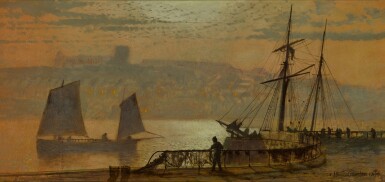
The Property of a Gentleman
John Atkinson Grimshaw
Moon, gas and starlight, Whitby
Auction Closed
July 3, 03:27 PM GMT
Estimate
80,000 - 120,000 GBP
Lot Details
Description
The Property of a Gentleman
John Atkinson Grimshaw
Leeds 1836–1893
Moon, gas and starlight, Whitby
signed and dated lower right: Atkinson Grimshaw 1877+
oil on artist's board
unframed: 21.3 x 45.2 cm.; 8⅜ x 17¾ in.
framed: 41.6 x 64.8 cm.; 16⅜ x 25½ in.
Anonymous sale, London, Sotheby's, 6 June 1980, lot 164;
Anonymous sale, London, Sotheby's, 4 June 1997, lot 145;
With Richard Green, London;
Where acquired by the parents of the present owner, 9 March 1998.
John Atkinson Grimshaw, exh. cat., London 1998, n.p., no. 10, reproduced in colour.
London, Richard Green, John Atkinson Grimshaw, 11 February – 7 March 1998, no 10.
One of the first of Grimshaw’s moonlit harbour scenes, Whitby Harbour by Moonlight (private collection) was painted in 1867, a decade before Moon, Gas and Starlight, Whitby and it was during that ten year period that the Yorkshire fishing town became a frequently recurring subject in Grimshaw’s oeuvre. The present picture was originally dated 1876 but re-dated by the artist to the following year - perhaps after making alterations to it.
Although Grimshaw rarely exhibiting his paintings of Whitby harbour they were immediately popular with collectors and quickly snapped up directly from the artist's studio. Grimshaw became increasingly interested in painting ships and the sea and although he painted the great ports of London, Glasgow, Liverpool and Hull, he also captured the more intimate harbours of the east coast of Yorkshire.
It was the mechanism of the port and the role in the life of the town which fascinated Grimshaw. His pictures are almost always populated by people and in the present picture he depicts fishermen idling in the moonlight, their nets hung along the railings to dry. Grimshaw's depiction of the port is full of painstaking detail and he celebrated its industrial role as one of the most active fishing ports of northern Britain. The lights of the fishing-boats reflecting in the still waters of the dock further suggest signs of the industry of the daylight hours – but it is now all in stasis. Rather than concentrating on the smoke and dirt of a busy port he chose a moonlit view and presented a beautifully detailed image. Pictures such as this appealed directly to the Victorian public's pride in their industrial achievements and explains Grimshaw's immense success as an artist. They also appealed to an audience responsive to romantic melancholy – not cloying sentimentality or mawkishness but quietude and reflection. The contrast of shadows, brilliant gas-light and soft moonlight in the present picture is typical of Grimshaw's oeuvre during the second half of his career. The artificial brightness of the gaslights together with the blackness of the boats and the nets in the foreground recall characteristics of collotype photography that developed in the late 18th century and which Grimshaw, as an artist, would have undoubtedly been aware of. The similarity between Grimshaw's atmospheric views of the harbour at Whitby and those by the contemporary photographer Frank Meadow Sutcliffe, has often been noted. Grimshaw and Sutcliffe are not known to have been acquainted and it is more likely that the photographer was influenced by the painter rather than visa versa.
As Alex Robertson has pointed out 'The 1870s were the period of Grimshaw's greatest success, with an increasingly popular local reputation, soon to spread to London...'.1 In 1874 one of his pictures was accepted by the Hanging Committee of the Royal Academy for inclusion in the Summer Exhibition and regular sales of his paintings made him financially more stable than he had been previously. From 1876 he was able to rent a second home at Scarborough, named Castle-by-the-Sea after a poem by Henry Longfellow. It was on this rugged Yorkshire coast that he painted some of his most atmospheric nocturnes including the dramatic The Burning of the Spa Saloon (Scarborough Art Gallery) an event he had witnessed in 1876 and In Peril of 1979 (Leeds City Art Galleries) to the more tranquil Whitby from Scotch Head of 1878 (Richard Green Gallery) and The Lighthouse at Scarborough of 1877 (private collection). The present picture was painted in the same year as The Lighthouse at Scarborough at the height of Grimshaw’s career.
1 A. Robertson, Atkinson Grimshaw, Oxford 1988, p. 35.
